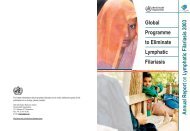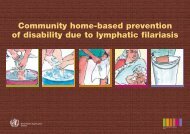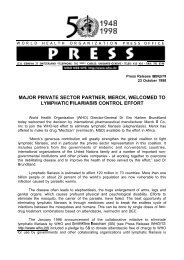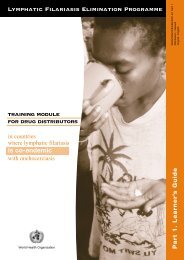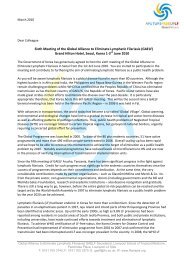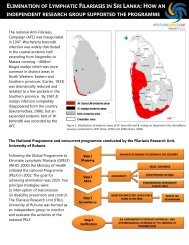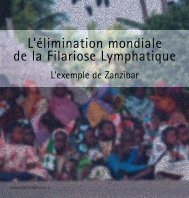English - Global Alliance to Eliminate Lymphatic Filariasis
English - Global Alliance to Eliminate Lymphatic Filariasis
English - Global Alliance to Eliminate Lymphatic Filariasis
Create successful ePaper yourself
Turn your PDF publications into a flip-book with our unique Google optimized e-Paper software.
REPORT OF THE 6 TH GAELF MEETING, JUNE 2010<br />
Cumulative reduction in in episodes of of adenolymphangitis (ADL) after introduction of of basic lymphoedema<br />
management lymphoedema (“foot management care”) in three (“foot countries care”) in three countries<br />
Half-time Around the World: Case Studies<br />
Elimination of <strong>Lymphatic</strong> <strong>Filariasis</strong> in India<br />
Dr. PK Srivastava, Joint Direc<strong>to</strong>r of the<br />
National Vec<strong>to</strong>r Borne Disease Control<br />
Programme, Ministry of Health and<br />
Welfare, reported that LF is endemic in<br />
250 districts in 20 states in India, with an<br />
at-risk population of 600 million. In 2009,<br />
MDA was conducted in all endemic<br />
districts with co-administered DEC and<br />
albendazole. MDA coverage (the<br />
percentage of the eligible population that<br />
receives antifilarial drugs) averaged 85%.<br />
Compliance (the percentage that actually<br />
takes the drug) was lower, but this figure<br />
is improving. The overall prevalence of<br />
microfilaremia decreased from 1.24% in<br />
2004 <strong>to</strong> 0.53% in 2008.<br />
Challenges for the India programme<br />
include the need for improved social<br />
mobilization and supervision <strong>to</strong> increase<br />
compliance with MDA, especially in urban<br />
areas; maintaining adequate supply and<br />
improving handling and s<strong>to</strong>rage of<br />
antifilarial drugs; access <strong>to</strong> technical<br />
expertise for moni<strong>to</strong>ring and evaluation of<br />
such a massive programme; moni<strong>to</strong>ring<br />
and surveillance in implementation units<br />
(IUs) that have met current WHO criteria<br />
for s<strong>to</strong>pping MDA; and expanding<br />
morbidity management activities.<br />
LF Elimination in Papua New Guinea<br />
Dr Leo Sora Makita, Health Advisor,<br />
Malaria and Vec<strong>to</strong>r Borne Disease,<br />
National Department of Health, discussed<br />
the challenges of LF elimination in Papua<br />
New Guinea, where an estimated 1 million<br />
of its 6.2 million inhabitants are infected<br />
with Wuchereria bancrofti and 3 million<br />
are at risk of infection. The prevalence of<br />
infection is as high as 92% in East Sepik<br />
Province. Although the national health<br />
plan, adopted in 2001, called for MDA and<br />
morbidity management in LF-endemic<br />
areas, progress has been slow due <strong>to</strong> the<br />
substantial challenges of dense forests,<br />
21



